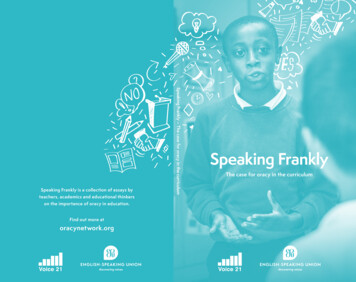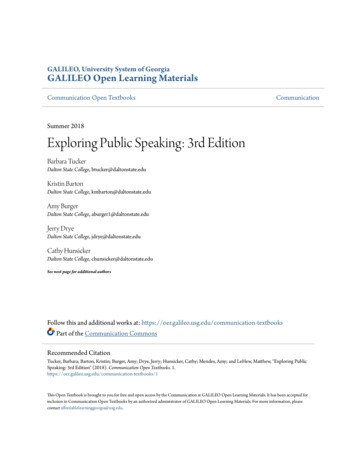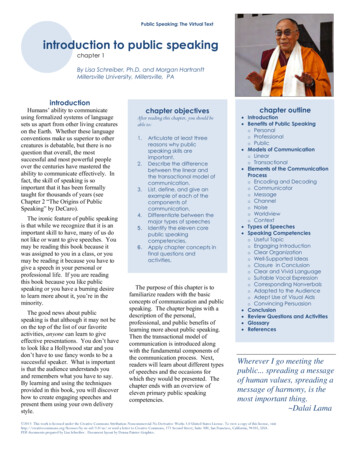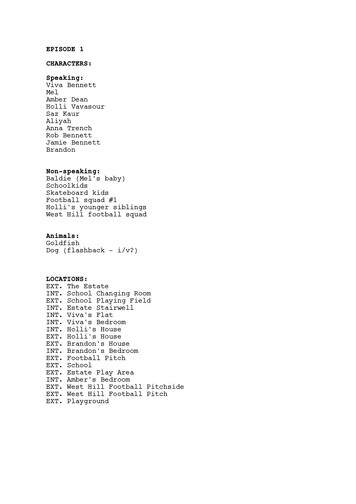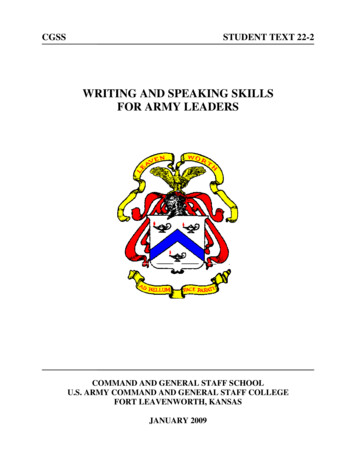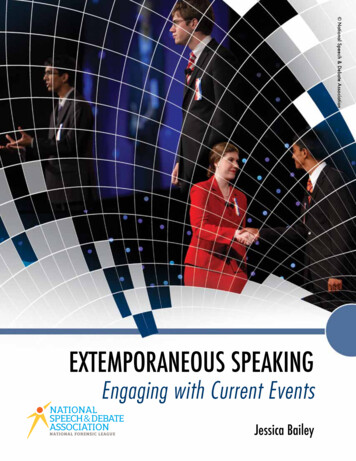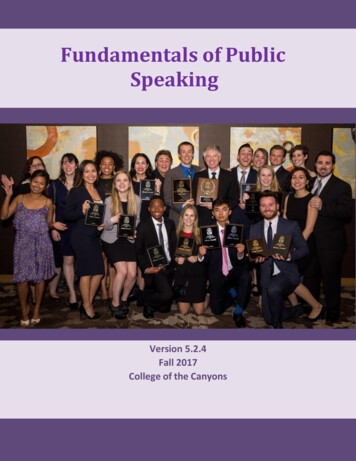
Transcription
Fundamentals of PublicSpeakingVersion 5.2.4Fall 2017College of the Canyons
Unless otherwise noted, content in this book is licensed underthe Creative Commons 4.0 License.
AttributionsThe Public Speaking Project by Various Authors is licensed under aCreative Commons Attribution-NonCommercial- NoDerivs 3.0 UnportedLicense.Saylor.org – Comm101: Public Speaking is licensed under aCreative Commons Attribution License.Reviewed and Edited ByTammera Stokes RiceSpecial Thank You to Natalie Miller andVictoria LeonardThis Material is a College of the Canyons Open Educational Resource (OER).To find out more about Open Educational Resources at College of theCanyons please visit: www.canyons.edu/OER or email OER@canyons.edu.
ContentsWelcome To Public Speaking . 2Chapter 1: Introduction To Public Speaking . 5Chapter 2: Ethics . 22Chapter 3: Speaking With Confidence. 42Chapter 4: Listening Effectively . 58Chapter 5: Audience Analysis . 78Chapter 6: Organizing and Outlining . 95Chapter 7: Introductions and Conclusions . 122Chapter 8: Delivering Your Speech. 149Chapter 9: Visual Aids . 208Chapter 10: Supporting Your Ideas . 239Chapter 11: Using Language Well . 277Chapter 12: Informative Speaking . 304Chapter 13: Critical Thinking & Reasoning . 321Chapter 14: Persuasive Speaking. 356Chapter 15: Special Occasion Speaking . 3961 College of the Canyons – Coms 105 Public Speaking
Welcome To Public SpeakingOVERVIEWGiven the demands for good communication skills in the civic realm and in the workplace,a course in public speaking is perhaps more important than ever. There is no quick path toa great speech. Good speaking is developed through practice and hard work.The public speaking course is a unique course. Unlike, say, a course in the principles of lawor the history of Central Asia, the public speaking course requires you to both know contentand be able to perform a skill well. You will learn important principles of public speaking,but simply knowing these principles is insufficient; you must also be able to apply themwell. By the same token, you might be able to get through a speech without saying “um,”but if the content of the speech is bad, it is not a good speech. The best public speakers notonly speak smoothly, they also say important and interesting things.Course Student Learning OutcomesBy the end of this semester, you should be able to1. Organize and deliver effective informative and persuasive speeches applying theprinciples of public speaking.2. Utilize effective research skills using traditional and electronic resources.3. Analyze public discourse.This course thus advances the mission of the Department of Communication at College ofthe Canyons to nurture socially responsible, literate citizens who can interpret and evaluatethe images and messages they create and receive.HOW TO BE A STUDENT OF PUBLIC SPEAKINGThe most successful model for teaching public speaking (and the one this class follows) relieson a mix of instruction, imitation, and practice. Instruction reinforces the lessons learned from the history of public speaking study.The instruction in this class draws most explicitly from the rhetorical tradition. Wewill study principles of argumentation, arrangement, and style. Imitation means that when studying a performance skill like speaking, we benefit byidentifying and imitating the best practices of skilled speakers. I don’t mean stealing2 College of the Canyons – Coms 105 Public Speaking
or plagiarizing, I mean trying to link phrases together in a manner similar to a speakerwe think sounds good. There are a number of speeches that you will watch duringthis course (online and in class). The intent of these speeches is to show you somebest practices. You shouldn’t simply watch a speech like you would a television show;you should look to find some verbal or nonverbal behaviors that you would like to beable to imitate. Practice is the most obvious leg of public speaking study. If you are going to get betterat public speaking, you must be able to apply the lessons of instruction and imitationby practicing your speeches. The nice thing about public speaking is that you canpractice it almost anywhere. However, your practice time is best spent by speaking insituations where you have an attentive audience (as opposed to a curious dog or asleeping roommate).MISCONCEPTIONS ABOUT PUBLIC SPEAKING1 You can’t learn to be a good public speaker; you have to be born a naturally goodspeaker. Everyone can become a better public speaker through study and practice.I love to ski. I wasn’t born a good skier; rather, I grew up skiing. I skied as often as Icould, and I got better. The same is true of public speaking. You were born with thebasic equipment needed for speaking in public—lungs and a mouth.2 I can only learn public speaking through practice. This misconception often worksin conjunction with the misconception #1 and #3. I see this as a hugely egoisticargument since it assumes that only you know what good public speaking is andonly you know how to improve. Let me return to the skiing analogy (though youcould substitute any sports or skills analogy, like playing a musical instrument).Most people develop their skiing ability by simply skiing a lot. But if you want toget better, you need to seek outside information about the principles of skiing.That’s why people pay a lot of money for ski lessons. Ski instructors can bothmodel good skiing behaviors and they can talk about the physics of metal on snowand the physiology of your muscles on skis.3 Public speaking is just delivery (speech content doesn’t matter). This is like sayingthat a good essay is simply one that has good grammar or punctuation. A goodessay should have good grammar and punctuation, but it also needs good content.The same holds true of a speech. When we listen to a speech we judge the speakeraccording to what they say as well as how they say it. Think about presidentialdebates. After any presidential debate, pundits flood the airwaves and pick apartboth content and delivery, but they spend far more time discussing what the3 College of the Canyons – Coms 105 Public Speaking
candidates said.4 Reading a speech is the best way to ensure a good speech. You will hear me talkinga lot about the similarities between writing and speaking, but they also differ inmany important respects. A speech is an act of communication with a specificaudience. Reading a speech undermines this (and as we will see, can actually makeyou more nervous). If you were having a conversation with a friend about yourclasses and suddenly started reading a prepared set of comments, the conversationwould sink. Why? A conversation is dynamic and relies on communicating with theother person. A speech is like a conversation in this way, you are engaging in ashared act of communication with the audience.As you can see, strong public speaking skills is not something that people are born with orsomething that we can do alone. Now that you have an idea of what to expect from thiscourse, what is expected of you, and why public speaking is vitally important, lets getstarted!4 College of the Canyons – Coms 105 Public Speaking
Chapter 1: Introduction To Public SpeakingBy: Lisa Schreiber, Ph.D. and Morgan Hartranft Millersville University, Millersville, PALEARNING OBJECTIVESAfter reading this chapter, you should be able to: Articulate at least three reasons why public speaking skills are important. Describe the difference between the linear and the transactional model ofcommunication. List, define, and give an example of each of the components of communication. Differentiate between the major types of speeches. Identify the eleven core public speaking competencies. Apply chapter concepts in final questions and activities.Introduction to Public Speaking: IntroductionHumans’ ability to communicate using formalized systems of language sets us apart fromother living creatures on the Earth. Whether these language conventions make ussuperior to other creatures is debatable, but there is no question that overall, the mostsuccessful and most powerful people over the centuries have mastered the ability tocommunicate effectively. In fact, the skill of speaking is so important that it has beenformally taught for thousands of years.The ironic feature of public speaking is that while we recognize that it is an important skillto have, many of us do not like or want to give speeches. You may be reading this bookbecause it was assigned to you in a class, or you may be reading it because you have togive a speech in your personal or professional life. If you arereading this book because you like public speaking or youhave a burning desire to learn more about it, you’re in theminority.The good news about public speaking is that although it maynot be on the top of the list of our favorite activities, anyonecan learn to give effective presentations. What is importantis that the audience understands you and remembers whatyou have to say. By learning and using the techniques5 College of the Canyons – Coms 105 Public Speaking
provided in this reading material, you will discover how to create engaging speeches andpresent them using your own delivery style.Benefits of Public SpeakingAccording to the Association ofAmericanCollegesandUniversities, there is a core set ofskills that are necessary “both fora globally engaged democracyand for a dynamic, innovationfueled economy” (Rhodes, 2010).In the category of “Intellectualand practical skills,” publicspeaking is listed as one of thesecore skills.Public speaking is the process ofdesigning and delivering amessage to an audience. Effectivepublic speaking involves understanding your audience and speaking goals, choosingelements for the speech that will engage your audience with your topic, and delivering yourmessage skillfully.Good public speakers understand that they must plan, organize, and revise their material inorder to develop an effective speech. This is not particularly surprising given thatcommunication skills are critical for intellectual development, career trajectory, and civicengagement. Public speaking is universally applicable to all types of majors and occupationsand is seen by U.S. employers as a critical employability skill for job seekers (Rockler-Gladen,2009). No matter what your ambitions and interests are, developing speaking skills willbenefit your personal, professional, and public life.PersonalPeople don’t just give presentations on the job and in classes. At times we are called uponto give speeches in our personal lives. It may be for a special event, such as a toast at awedding. We may be asked to give a eulogy at a funeral for a friend or loved one. We mayhave to introduce a guest speaker at an event or present or accept an award for service.Developing the skill to give these types of speeches can help us to fulfill essential roles inour family and community. Another great personal benefit of public speaking is that itbuilds self-confidence. It’s no surprise that speaking in public is scary, but by engaging in6 College of the Canyons – Coms 105 Public Speaking
the activity you will build self-confidence through the experience.ProfessionalTV announcers, teachers, lawyers, andentertainers must be able to speak well, but mostother professions require, or at the very least, canbenefit from the skills found in public speaking. Itis believed 70% of jobs today involve some form ofpublic speaking (Aras, 2012).With therecent economic shift frommanufacturing to service careers, the ability tocommunicate with others has become crucial. TopCEOs advise that great leaders must be able tocommunicate ideas effectively; they must be ableto persuade, build support, negotiate and speakeffectively in public (Farrell, 2013).The chapters on “Informative Speaking” and “Persuasive Speaking” can help readersunderstand how to write presentations that enhance their leadership skills. But before youeven start a career, you have to get a job. Effective speaking skills make you more attractiveto employers, enhancing your chances of securing employment and later advancing withinyour career.Employers, career counselors, and the National Association of Colleges and Employers(NACE) all list good communication skills at the top of the list of qualities sought in potentialemployees. According to NACE’s executive director, Marilyn Mackes, the Job Outlook 2013Report found that employers are looking for people who can communicate effectively (Koncz& Allen, 2012). Monster.com advises, “articulating thoughts clearly and concisely will makea difference in both a job interview and subsequent job performance” (McKay, 2005).Action is a great restorer and builder of confidence. Inaction is not only the result, but the cause, offear. Perhaps the action you take will be successful; perhaps different action or adjustments will haveto follow. But any action is better than no action at all. Norman Vincent PealePublicLearning about public speaking will allow you to participate in democracy at its mostbasic level. Public speaking is important in creating and sustaining a society, which7 College of the Canyons – Coms 105 Public Speaking
includes informed, active participants. Even if you do not plan to run for office, learningabout public speaking helps you to listen more carefully to and critically evaluate othersspeeches. Listening and critical thinking allow you to understand public dilemmas, forman opinion about them, and participate in resolving them. The progress of the pastcentury involving segregation, women’s rights, and environmental protection are theresult of people advancing new ideas and speaking out to others to persuade them toadopt changes.Introduction to Public Speaking: Models of CommunicationIt should be clear by now that public speaking happens all around us in many segments ofour lives. However, to truly understand what is happening within these presentations, weneed to take a step back and look at some of the key components of the communicationprocess.Linear Model of CommunicationThe first theoretical model of communication was proposed in 1949 by Shannon andWeaver for Bell Laboratories. This three-part model was intended to capture the radio andtelevision transmission process. However it was later adapted to human communicationand is now known as the Linear Model of Communication.The first part of the model is the sender, and this is the person who is speaking. The secondpart of the model is the channel, which is the apparatus for carrying the message (i.e., thephone or TV). The third part of the model is the receiver, and this is the person who picksup the message.In this model, communication is seen as a one-way process of transmitting a message fromone person to another person. This model can be found in Figure 1.1. If you think aboutsituations when you communicate with another person face-to-face or when you give aspeech, you probably realize that this model is inadequate—communication is much morecomplicated than firing off a message to others.8 College of the Canyons – Coms 105 Public Speaking
Transactional Model of CommunicationModels of communication have evolved significantly since Shannon and Weaver firstproposed their well- known conceptual model over sixty years ago. One of the most usefulmodels for understanding public speaking is Barnlund’s Transactional Model ofCommunication. In this model, communication is seen as an ongoing, circular process. Weare constantly affecting and are affected by those we communicate with.The transactional model has a number of interdependent processes and components,including the encoding and decoding processes, the communicator, the message, thechannel and noise. Although not directly addressed in Barnlund’s (2008) originaltransactional model, participants’ worldviews and the context also play an important rolein the communication process. See Figure 1.2 for an illustration.9 College of the Canyons – Coms 105 Public Speaking
He who would learn to fly one day must first learn to stand and walk and runand climb and dance; one cannot fly into flying. Friedrich NietzscheIntroduction to Public Speaking: Elements of the CommunicationProcessEncoding and DecodingEncoding refers to the process of taking ideas, thoughts feelings, or mental images, andassociating those with words, and then speaking those words in order to convey a message.So, if you wanted to explain to your aunt the directions to your new apartment, you wouldpicture in your mind the landscape, streets and buildings, and then you would select thebest words that describe the route so your aunt could find you.10 C o l l e g e o f t h e C a n y o n s – C o m s 1 0 5 P u b l i c S p e a k i n g
Decoding is the reverse process of encoding. It involves listening to words, thinking aboutthem, and converting those words into mental images, thoughts, feelings, and ideas. If youraunt were trying to find her way to your apartment, she would listen to your words,associate these words with streets and landmarks that she knows, and then she would forma mental map of the way to get to you. Using Language Well (Chapter 11) providesadditional insight into the encoding and decoding processes.CommunicatorThe term communicator refers to each person in the interaction or speech setting. It isused instead of sender and receiver, because when we are communicating with otherpeople, we are not only sending a message, we are receiving messages from otherssimultaneously.When we speak, we observe others’ nonverbal behavior to see if they understand us, andwe gauge their emotional state. The information we gain from these observations is knownas feedback. Over the telephone, we listen to paralinguistic cues, such as pitch, tone,volume, and fillers (i.e., “um,” “uh,” “er,” “like,” and so on). This means that communicationis not a one-way process.Even in a public speaking situation, we watch and listen to audience members’ responses.If audience members are interested, agree, and understand us, they may lean forward intheir seats, nod their heads, have positive or neutral facial expressions, and providefavorable vocal cues (such as laughter, “That’s right,” “Uh huh,” or “Amen!”). If audiencemembers are bored, disagree, or are confused by our message, they may be texting orlooking away from us, shake their heads, have unhappy or confused expressions on theirfaces, or present oppositional vocal cues (like groans, “I don’t think so,” “That doesn’t makesense,” or “You’re crazy!”). Thus, communication is always a transactional process—a giveand take of messages.MessageThe message involves those verbal and nonverbal behaviors enacted by communicatorsthat are interpreted with meaning by others. The verbal portion of the message refers tothe words that we speak, while the nonverbal portion includes our tone of voice and othernon-vocal components such as personal appearance, posture, gestures and bodymovements, eye behavior, the way we use space, and even the way that we smell.For instance, the person who gets up to speak wearing a nice suit will be interpreted morepositively than a person giving the exact same speech wearing sweats and a graphic t- shirt.Or if a speaker tries to convince others to donate to a charity that builds wells in poor11 C o l l e g e o f t h e C a n y o n s – C o m s 1 0 5 P u b l i c S p e a k i n g
African villages using a monotone voice, she will not be as effective as the speaker whogives the same speech but speaks with a solemn tone of voice. If there is ever a conflictbetween the verbal and the non-verbal aspects of a message, people will generally believethe nonverbal portion of the message.To test this, tighten your muscles, clench your fists at your sides, pull your eyebrowstogether, purse your lips, and tell someone in a harsh voice, “NO, I’m NOT angry!” See ifthey believe your words or your nonverbal behavior.The message can also be intentional or unintentional. When the message is intentional,this means that we have an image in our mind that we wish to communicate to anaudience or a person in a conversation, and we can successfully convey the image fromour mind to others’ minds with relative accuracy.An unintentional message is sent when the message that we wish to convey is not thesame as the message the other person receives. Let’s say you are returning from an outingwith your significant other and she or he asks, “Did you have a good time?” You did havea good time but are distracted by a TV commercial when asked, so you reply in a neutraltone, “Sure, I had fun.” Your significant other may interpret your apathetic tone of voiceand lack of eye contact to mean that you did not enjoy the evening, when in fact youactually did. Thus as communicators, we cannot always be sure that the message we wishto communicate is interpreted as we intended.ChannelThe channel is very simply the means through which the message travels. In face-to-facecommunication, the channel involves all of our senses, so the channel is what we see, hear,touch, smell, and perhaps what we taste. When we’re communicating with someoneonline, the channel is the computer; when texting, the channel is the cell phone; and whenwatching a movie on cable, thechannel is the TV.The channel can have a profoundimpact on the way a message isinterpreted. Listeningto arecording of a speaker does nothave the same psychological impactas listening to the same speech inperson or watching that person ontelevision.12 C o l l e g e o f t h e C a n y o n s – C o m s 1 0 5 P u b l i c S p e a k i n g
One famous example of this is the 1960 televised presidential debate between John F.Kennedy and Richard Nixon. According to History.com (2012), on camera, Nixon lookedaway from the camera at the reporters asking him questions, he was sweating and pale, hehad facial hair stubble, and he wore a grey suit that faded into the set background. “Chicagomayor Richard J. Daley reportedly said [of Nixon], ‘My God, they’ve embalmed him beforehe even died’” (History.com).Kennedy, on the other hand, looked into the camera, was tanned, wore a dark suit thatmade him stand out from the background, and appeared to be calm after spending theentire weekend with aides practicing in a hotel room. Most of those who listened to theradio broadcast of the debate felt that it was a tie or that Nixon had won, while 70% ofthose watching the televised debate felt that Kennedy was the winner.NoiseThe next aspect of the model of communication is noise. Noise refers to anything thatinterferes with message transmission or reception (i.e., getting the image from your headinto others’ heads). There are several different types of noise. The first type of noise isphysiological noise, and this refers to bodily processes and states that interfere with amessage. For instance, if a speaker has a headache or the flu, or if audience members arehot or hungry these conditions may interfere with message accuracy.The second type of noise is psychological noise. Psychological noise refers to mental statesor emotional states that impede message transmission or reception. For example, ifsomeone has just broken up with a significant other, or if they’re worried about theirgrandmother who is in the hospital, or if they are thinking about their shopping list, thismay interfere with communication processes as well.The third type of noise is actual physical noise, and this would be simply the actual soundlevel in a room. Loud music playing at a party, a number of voices of people talkingexcitedly, a lawnmower right outside the window, or anything that is overly loud willinterfere with communication.The last type of noise is cultural noise. Cultural noiserefers to message interference that results fromdifferences in peoples’ worldviews. Worldview isdiscussed in more detail below, but suffice it to say thatthe greater the difference in worldview, the moredifficult it is to understand one another andcommunicate effectively.13 C o l l e g e o f t h e C a n y o n s – C o m s 1 0 5 P u b l i c S p e a k i n g
WorldviewMost people don’t give a lot of thought to the communication process. In the majority ofour interactions with others, we are operating on automatic pilot. Although the encodingand decoding processes may appear to be fairly straightforward, it is actually much morecomplicated than it seems. The reason for this is because we all have differentworldviews. Worldview is the overall framework through which an individual sees, thinksabout, and interprets the world and interacts with it. There are five core components toour worldview.1. Epistemology is the way that we acquire knowledge and/or what counts asknowledge. Think about the process of conducting research. Thirty years ago, to find aseries of facts, one had to use a card catalogue and scour the library stacks for books. Nowresearchers can access thousands of pages of information via their computer from thecomfort of their own home. Epistemology is linked to public speaking because it governsaudience members’ preferred learning styles and who or what they consider to becredible sources.2. Ontology refers to our belief system, how we see the nature of reality or what we seeas true or false. We may (or may not) believe in aliens from outer space, that butter is badfor you, that the Steelers will win the Superbowl, or that humans will be extinct in 200years. Speechwriters should be careful not to presume that audience members share thesame beliefs. If a speaker claims that illness can be aided with prayer, but several peoplein the audience are atheists, at best the speaker has lost credibility and at worst theseaudience members could be offended.3. Axiology represents our value system, or what we see as right or wrong, good or bad,and fair or unfair. One of the ways that you can tell what people value is to ask them whattheir goals are, or to ask them whatqualities they look for in a lifepartner. Values can have an impacton multiple levels of the publicspeaking process, but in particular,values impact speaker credibilityand effectiveness in persuasion. Forinstance, some cultures valuemodest dress in women, so wearing asleeveless shirt while presenting couldcause a female to lose credibility withsome audience members. Or ifaudiencemembers value the14 C o l l e g e o f t h e C a n y o n s – C o m s 1 0 5 P u b l i c S p e a k i n g
freedom to bear arms over the benefits of government regulation, a speaker will have adifficult time convincing these audience members to vote for stricter gun controllegislation.4.Cosmology signifies the way that we see our relationship to the universe and to otherpeople. Cosmology dictates our view of power relationships and may involve our religiousor spiritual beliefs. Controversial speech topics (like universal health care and the deathpenalty) are often related to this aspect of worldview as we must consider our responsibilitiesto other human beings and our power to influence them. Interestingly, cosmology would alsoplay a role in such logistical points as who is allowed to speak, the order of speakers on aschedule (e.g., from most to least important), the amount of time a speaker has to speak,the seating arrangement on the dais, and who gets the front seats in the audience.5.Praxeology denotes our preferred method of completing everyday tasks or ourapproach to solving problems. Some speech writers may begin working on their outlines assoon as they know they will need to give a speech, while others may wait until a few daysbefore their speech to begin preparing (we do not recommend this approach). Praxeologymay also have an impact on a speaker’s preference of delivery style, methods of arrangingmain points, and choice of slideware (i.e., Power Point versus Prezi).It is always good to explore the stuff you don’t agree with, to try and understand a differentlifestyle or foreign worldview. I like to be challenged in that way, and always end up learningsomething I didn’t know. Laura LinneyIt is important to understand worldview because it has a profound impact on the encodingand decoding processes, and consequently on our ability to be understood by others. Trythis simple experiment: ask two or three people to imagine a dog while you imagine a dogat the same time. “Dog” is a very concreteword (a word that describes a tangibleobject that can be perceived through thesenses), and it is one of the first wordschildren in the United States learn in school.W
a course in public speaking is perhaps more important than ever. There is no quick path to a great speech. Good speaking is developed through practice and hard work. The public speaking course is a uniq
